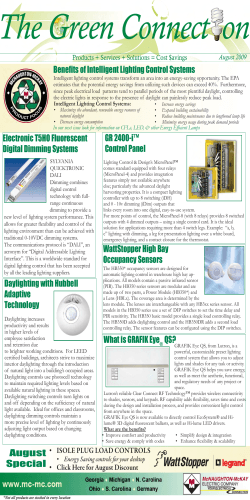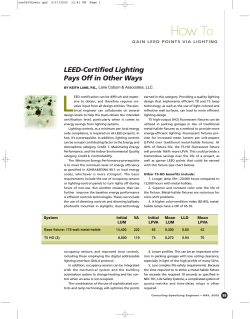
Industry and Competitive Situation Analysis
Team # 6 Kyle Kunkel John Barron Parker Teddy Lathrop Thor Fink General Electric History Founded in Schenectady, New York in 1892 Thomas Edison, Elihu Thomson, Charles Coffin, and Edwin Houston. Merger between Edison General Electric and Thomas Houston Company Went public in 1896, 1 of 12 companies On the DOW Company Overview American Multinational Conglomerate Headquartered in Fairfield, Connecticut 10th Largest company in the world Four Sectors: Energy, Capital Finance, Technology Infrastructure, and Consumer and Industrial Major Mergers, Buyouts, and Sells since GE’s Formation 1911 GE combined with the National Electric Lamp Company. (NELC) 1919 established the Radio Corporation of America 1960s one of the worlds largest computer companies 2002 Sold IS to Francisco Partners and Norwest Venture Partners. 2004 it took over the television company NBC and Media Conglomerate Vivendi Overview Continued Operate in more than 160 countries 305,000 Employees worldwide Energy Products help Provide for over a ¼ of the worlds Electricity supply. Market capitalization of about $227.6 billion as of April, 26, 2013 General Electric Leadership Jeff Immelt; Current CEO and Board Member Barron named Immelt the Worlds best CEO 3 times Appointed financial advisor By President Barack Obama Publication Recognition “Most Admired Company” (Forbes) 19th “Most Innovative Company In the World” (FastCo) 15th “most admired company” (Fortune) 7th “for creating company leaders” (Fortune) 5th “best global brand” (Interbrand) 63rd “worlds greenest companies” (Newsweek) 2011 GE 6th “US Largest Firms” (Fortune 500) Currently ranked 3rd “most profitable company”(Forbes) 2012 Awards Named in Barron's list of the most respected companies. Among Fortune's listing of the world’s most admired companies and the top companies for leaders. Bloomberg BusinessWeek's list of the world's most innovative companies. Named in Ethisphere's list of the world's most ethical companies. Organizational Structure Hierarchal system Allowed more freedom for lower employees, enables them to move forward company without bureaucratic obstacles slowing them down. Eliminate Bureaucratic “Roadblocks” Helps Speed up decision making process/ insures the company is more productive and efficient. Company Culture Many companies try to adopt GE’s Methods and Co. Culture. Upper MGMT encourages employees to speak their minds and compensate accordingly for innovativeness. Draw innovation from all levels of employees Former CEO Jack Welch implemented system called “Re-architecting” 4 Principles GE lives by 4 Ideas Imagine Build Solve Lead http://www.youtube.com/watch?v=loinY8MmVq8 Research & Development Approximately 36,000 technologist working R&D 10 R&D Centers worldwide R & D centers in Niskayuna, New York San Ramon, California Oklahoma City Munich, Germany Bangalore, India Shanghai, China R&D continued Ranked 19th most innovative Co in 2011 (Fast Company) Funded R&D for $4,601 million in 2011. $3,939 million 2010. And $3,288 million in 2009. R & D capabilities allows GE to expand into new markets. Key Factors to Success Diverse Portfolio Creating Successful Leaders Extensive R & D Competition Large number of competitors due to size of the CO. Largest Competitors Include: Siemens AG ABB Other Companies include: BSH Bosch and Siemens Whirlpool AB Electrolux Haier Group Company Phillips Lighting BV OSRAM GmbH Economic Factors Fluctuating interest rates Foreign exchange rates Money value affected by GE operations. Over past years company suffered a decrease in revenue and sales Stock Price Political Factors Located in 160 different countries Company has to adjust to various government laws, regulations, and cultural norms. Strategy taken Financials have slowly been declining over the last couple of years due to the recession but revenues have been making a comeback Environmentally friendly manufacturing Ecokitchen idea SWOT Analysis Strengths Managers and management school Technology advances Research and Development SWOT continued Weaknesses Legal issues Dependence on third party venders SWOT continued Opportunities LED technology Street-light programs Business alliances: Chesapeake SWOT continued Threats Government rules and regulations (EPA) Intellectual property theft Competitive analysis In 2012, GE was named in Barron's list of the most respected companies. In 2012, GE ranked among Fortune's listing of the world’s most admired companies and the top companies for leaders. In 2012, GE was named in Bloomberg BusinessWeek's list of the world's most innovative companies. In 2012, GE was named in Ethisphere's list of the world's most ethical companies,”(GE web page, 2013, company fact sheet). Assets Infrastructure Technology Cash that can be spent to invest Cost Analysis Growth More expansion 8% compared 3% Amount spent on R&D Issues Fukushima, Japan Resource scarcity GE’s Position in the Appliance Industry In the appliance industry, General Electric is recognized as one of the best-known brand name appliance manufacturers in the world The competitive strategy GE uses is based off the company’s core technology, manufacturing and marketing where they are able to produce approximately $5.5 billion in revenues With technological advances over the past couple of years, energy efficient appliances has shown to be the future if the appliance industry GE Becoming More Energy-Efficient GE has shown to be on a steady rise with the production of energy efficient appliances Smart meters Smart platforms Smart appliances This new wave of energy-efficient products will save consumers money in the long run What Options Does GE Appliances Have Moving Forward? As GE continues to grow in the appliance industry, it is important for them to stay the course they have already established Proven to be among industry leaders in innovative, energy- efficient technologies In an industry that is becoming more promotionally driven, GE should focus more of its resources towards marketing and advertising in order to increase their sales revenues Offering a greater incentive to buy GE appliances versus their competitors will bring new customers in and retain the customer base they already have GE’s Position in the Lighting Industry In the lighting industry, General Electric’s commercial and residential lighting division is leading the way as a proven expert in the light-emitting diode (LED) category Acquisitions of Lightech and Nuventix in 2011 provided GE Lighting with the resources needed to develop industry leading LED products GE’s position in the Lighting Industry cont. With lighting consumer trends shifting towards an increase in demand for energy efficient products and fast-paced technology advances, GE lighting is at the top when it comes to producing innovative, industry leading, energy-saving lighting products GE Making a Difference The amount of money General Electric saves other businesses through their energy efficient products and business strategy is more than any other competitor in the lighting industry Ex. Plaza Indonesia What Options Does GE Lighting Have Moving Forward? For GE to continue to grow in the lighting industry it is important that they do not out innovate themselves and they continue to grow LED technology Phase out of out-dated incandescent designs Develop a marketing strategy that exemplifies the benefits of LED technology General Electric as a Whole For General Electric as a whole, it is important that they keep the company divided into separate business entities It is hard to analyze GE from a shareholder prospective because of the variety of industries they compete in There is a tremendous unrealized shareholder value that needs to be exploited and the best way for that to happen is to let each business entity flourish as a separate company GE Appliances & Lighting Operates as part of GE’s Home & Business Solutions unit Makes home appliances as well as provides appliance repair service Home to GE’s lighting division Make lighting products for residential and commercial markets Products Appliances Lighting Dishwashers CFL bulbs Dryers Florescent bulbs Freezers Halogen bulbs Ovens Incandescent bulbs Refrigerators LEB bulbs Room AC units Washing Machines Appliance Industry NAICS 3352 definition: Household Appliance Manufacturing Comprises of establishments primarily engaged in manufacturing both small and major electrical appliances and parts. Overview Projected 4% annual growth in global demand through 2015 Mostly dominated by multinational conglomerates with a wide-range of products Competition intense among leaders Design and product innovation Very high entry barriers Other Features Cyclical industry-dependent upon consumer discretionary spending Highly concentrated market due to: high fixed costs of maintaining and operating giant plants huge investing into R&D the need to have size and power in order to put pricing pressures on their suppliers Current Trends & Beyond Energy-saving and eco-friendly products, or “smart” appliances, are dominating demand Technological innovation & user integrated features are important in the future India is expected to have strongest rate of growth in the global major appliances market over the coming years Main Competitors Whirlpool Corp Investing into emerging markets such as China Major customer’s include: Lowe’s, Home Depot, Sears, and Best Buy Bosch and Siemens (BSH) Attempting to enter retail market EPA Energy Star certified across its lineup AB Electrolux Reformation of manufacturing strategy Company’s extensiveness makes them a worldwide leader Haier Group Company China's #1 appliance manufacturer Pursues markets beyond appliances through acquisitions and joint ventures Lighting Industry NAICS 3351 Definition: Electric Lighting Equipment Manufacturing Comprises of establishments primarily engaged in manufacturing electric lamp bulbs, lighting fixtures, and parts. Overview Projected 4.5% annual growth in global demand through 2014 factors fuelling the market growth are: rise in personal income and recovery in automotive industry LEDs and fluorescents (CFL) costs are forecast to decline, increasing demand Demand for these products will encroach on demand for other types of lighting Other Features Demand depends primarily on residential, industrial, and commercial construction activity Large companies have advantages in purchasing power, manufacturing volume, and distribution efficiencies Small companies compete by offering specialized products and superior customer service in regional markets Market Outlook Developing countries are expected to have fastest growth in electric lighting demand CFL and LED lighting are expected to show the fastest growth in the lighting industry Technological advances and cost reduction are fueling the LED market growth CFL is being used to replace incandescent lamps and will grow at a faster rate The market has been quite concentrated to date it is likely that competition will stiffen as new outfits enter the market Main Competitors Phillips Lighting B.V. the #1 household light bulb maker made good plans to expand into developing geographic markets OSRAM GmbH a division within Siemens AG's Industry business sector Siemens spun off OSRAM during the spring of 2013 and will cut about 4,700 jobs or about 12% of its overall workforce China Intelligent Lighting and Electronics, Inc. does most of its business in China and sells its products through more than 60 original equipment manufacturers (OEMs) intends to focus on increasing its OEM customer base and growing its distribution network
© Copyright 2026















